New Hampshire is known as The Granite State and is located in the northeastern part of the United States. In terms of geography, the state is split into seven regions – the Dartmouth-Lake Sunapee, the Monadnock Region, the Merrimack Valley, the Seacoast, the Lakes Region, the White Mountains, and the Great North Woods. New Hampshire is famously known for having the shortest coastline of all coastal states in the U.S.
Regarding animal life, New Hampshire is home to the beautiful white-tailed deer and the red fox, raccoon, piping plover, snowshoe hare, and White Mountain fritillary butterfly. There are over 500 vertebrate species living in the Granite State.
In terms of flora, the state hosts roughly 1,500 species of plants known as native vascular plants. Of these, almost 400 are protected by the Native Plant Protection Act. In the following lines, you’ll find out more about some of the plants that New Hampshire is proud to call native!
What Is a Native Plant?
Native plants are plants known to have been growing naturally in a certain region/area for thousands of years. These plants are often referred to as indigenous – just as in the case of people that have inhabited an area for a very long time.
As native, these plants showcase excellent adaptation to the region’s climate, light, soil condition, and ecosystem.
8 Native Plants in New Hampshire
1. Quaking Aspen
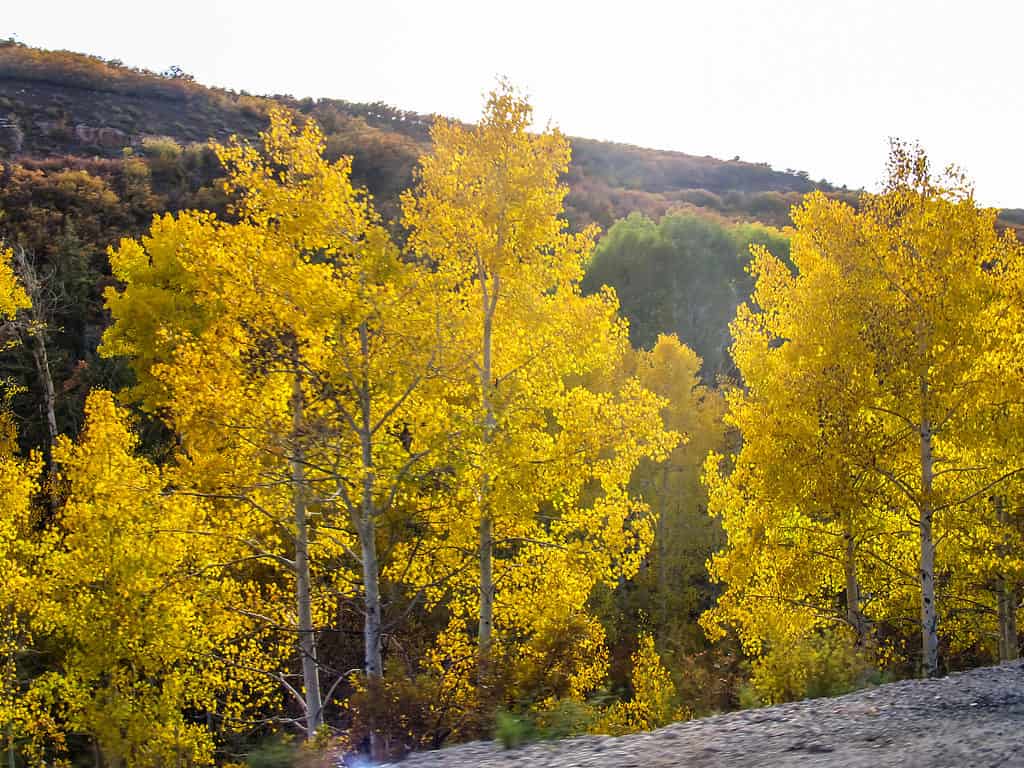
The quaking aspen usually grows up to 50-60 feet.
©iStock.com/Marieke Peche
| Quaking Aspen | |
|---|---|
| Scientific name | Populus tremuloides |
| Type of plant | Deciduous |
| Distribution | North America |
The quaking aspen is also known as trembling, American, golden, or mountain aspen and white and trembling poplar, including the diminutive popple. Many names, right?! They’re deserved, given that this is North America’s most widely distributed tree species, with large populations in Canada and eastern North America.
The quaking aspen usually grows up to 50-60 feet (15-18 m). The species can grow much more, as records tell of specimens as tall as 119 feet 9 inches (36.5 m). You can identify quaking aspens by their tall trunks, smooth and pale bark, and autumnal golden yellow leaves.
One of the most interesting aspects of the species is the way it propagates. Quaking aspen trees are found in groves created from a shared root system. Essentially, every tree can originate from the same root, often leading to quaking aspen groves being called clonal groves.
2. Butternut
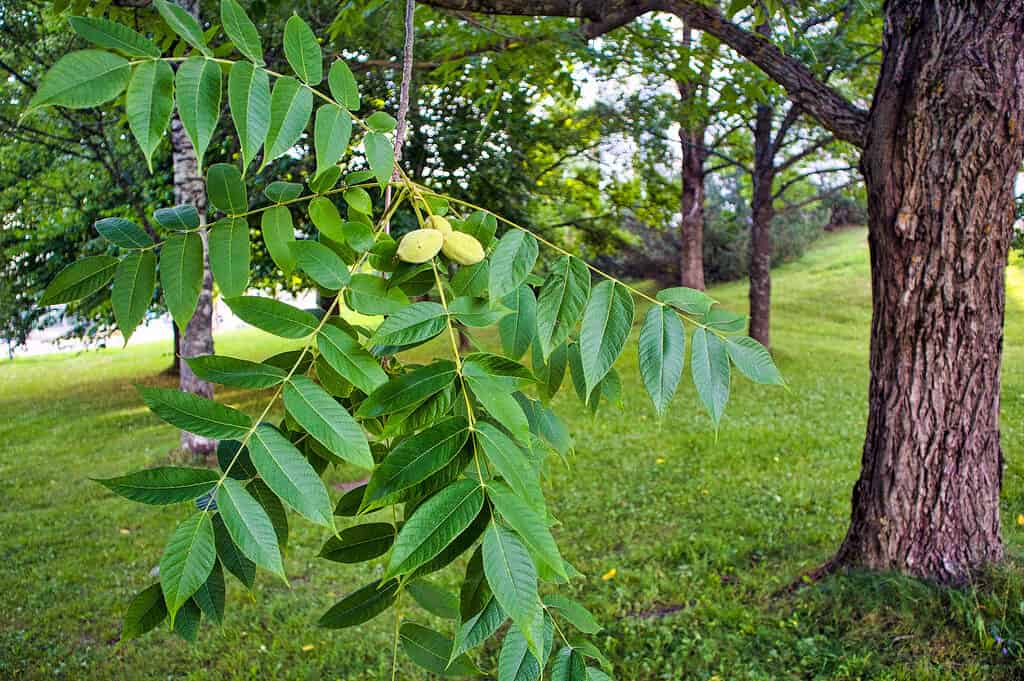
The butternut is part of the
Juglandaceae(walnut) family.
©iStock.com/Esa Hiltula
| Butternut | |
|---|---|
| Scientific name | Juglans cinerea |
| Type of plant | Deciduous |
| Distribution | Eastern United States, southeastern part of Canada |
The butternut, also known as the white walnut, is part of the Juglandaceae (walnut) family. It can be found throughout southeastern Canada and the eastern United States. Compared to other species on this list, the natural range of the butternut is quite limited.
The butternut grows to heights of about 66 feet (20 m), but it can reach double the size, depending on growing conditions. It grows quite slowly, making it a rather long-living species, with a lifespan of over 75 years.
It is characterized by a thick trunk and large leaves – they grow up to 16-28 inches (40-70 cm) long. The tree fruits are edible nuts that can be pickled, depending on preferences.
One famous butternut specimen is the Bush butternut tree planted in 1845 by George Bush. It grew in Washington but had been initially planted in Missouri – it fell on the 1st of May, 2021, at 176 years old.
3. Highbush Blueberry
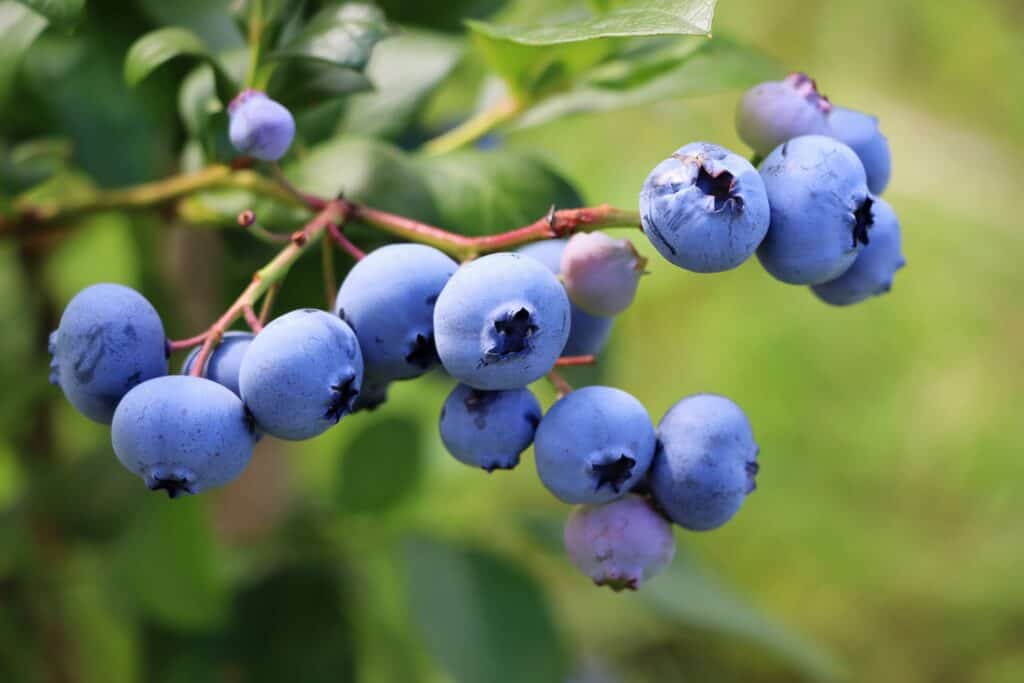
The highbush blueberry is part of the
Ericaceaefamily and is essentially a blueberry shrub.
©vaivirga/Shutterstock.com
| Highbush Blueberry | |
|---|---|
| Scientific name | Vaccinium corymbosum |
| Type of plant | Deciduous |
| Distribution | Eastern Canada, eastern and southern United States |
Usually known as the northern highbush blueberry, swamp huckleberry, high blueberry, and swamp blueberry, the highbush blueberry is part of the Ericaceae (heath, heather) family and is essentially a blueberry shrub. Throughout time, the shrub has been recognized as having significant economic importance thanks to its high crop yield.
While the species is native to the eastern and southern United States and eastern Canada, specimens can also be found in other regions like Japan, Europe, and New Zealand. Its popularity led to its naturalization throughout the world.
The highbush blueberry shrub usually grows up to and as wide as 6-12 feet (1.8-3.7 m). You can spot it hiding in dense thickets, as it is easily recognizable thanks to its blue fruits.
4. Smooth Sumac

The smooth sumac usually grows up to 9.8 feet tall.
©Burning Bright/Shutterstock.com
| Smooth Sumac | |
|---|---|
| Scientific name | Rhus glabra |
| Type of plant | Perennial |
| Distribution | Throughout North America (mainly the eastern half) |
Also known as the scarlet, white, or upland sumac, the smooth sumac is native to the eastern half of North America, with isolated populations in the western half as well. However, you’re most likely to encounter this beautiful species in the Great Lakes region and close to the coastline, including New Hampshire.
If you’re out and about for sumac, it is highly recommended to do so when the species are mature and have fruit. This is because it can be easily mistaken for Toxicodendron vernix (poison sumac), as they look similar until they bear fruit.
The smooth sumac usually grows up to 9.8 feet (3 m) tall, but some specimens can attain almost double the size. Naturally, the main characteristic of the species is the fruit – an edible crimson berry gathered alongside others in large panicles.
5. Winterberry
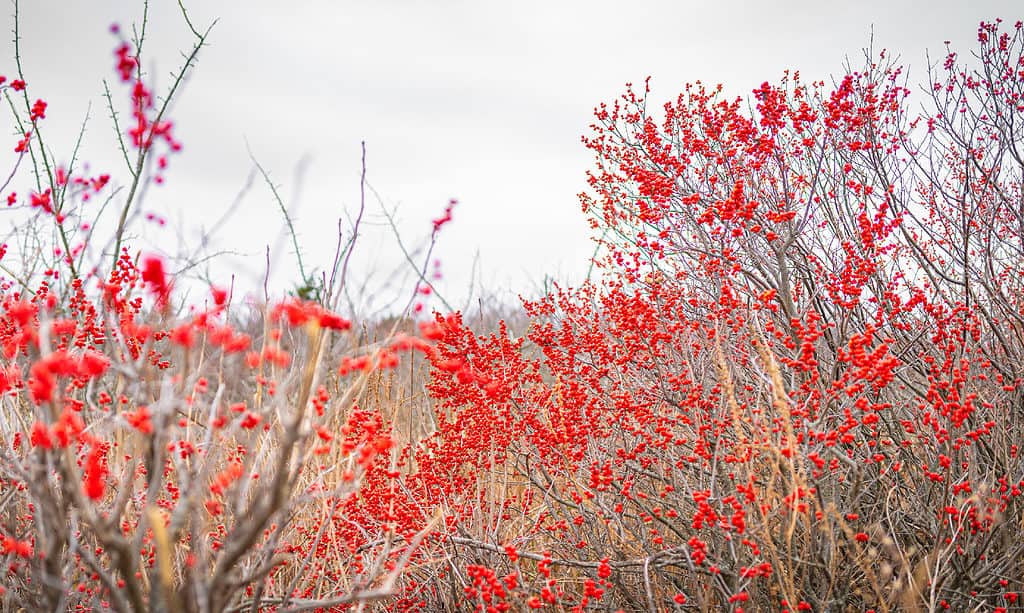
The winterberry is part of the
Aquifoliaceaefamily and is essentially a holly shrub.
©iStock.com/Sanghwan Kim
| Winterberry | |
|---|---|
| Scientific name | Ilex verticillata |
| Type of plant | Deciduous |
| Distribution | Eastern North America, southeast Canada |
The winterberry can be found on the eastern coastline of North America, with a rather limited natural range. It is part of the Aquifoliaceae family and is essentially a holly shrub. People call it winterberry holly, black alder, coralberry, fever bush, Michigan holly, or Canada holly, mostly depending on location.
The winterberry usually grows up to 3-16 feet (1-5 m) tall and is characterized by the fact that it forms dense thickets while spreading – but only when it’s found in wet soil. If the plant grows in dry soil, it will keep its tight shrub form throughout its life.
The winterberry fruit is a drupe, red in color, and quite small – only about 0.24-0.31 inches (6-8 mm) wide. It is well known that the fruits can persist well into the winter, hence the name of this beautiful plant.
6. Bittersweet
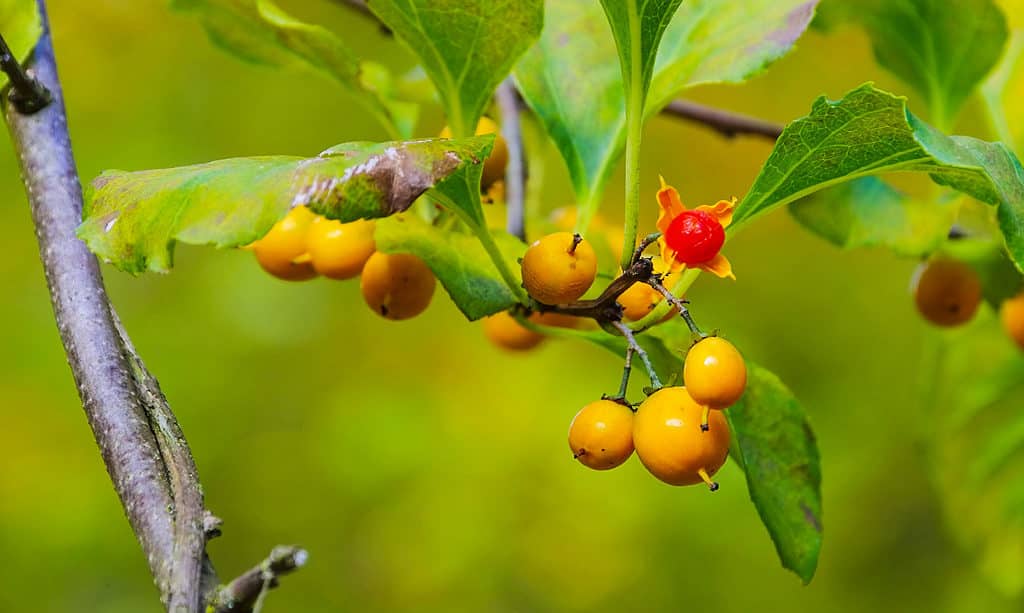
The American bittersweet is part of the
Celastrusgenus, which consists mainly of vines and shrubs.
©LianeM/Shutterstock.com
| Bittersweet | |
|---|---|
| Scientific name | Celastrus scandens |
| Type of plant | Perennial |
| Distribution | Central and eastern North America |
The American bittersweet, or just bittersweet, is a vine part of the Celastrus genus, which consists mainly of vines and shrubs. This plant is native to central and eastern North America only. Contrary to popular belief, the name bittersweet doesn’t stem from the fact that its fruits are bitter-sweet. Instead, it was given by 18th-century colonists upon noticing that the fruits closely resembled those of Solanum dulcamara (nightshade), a species then called bittersweet.
The American bittersweet usually grows up to 30 feet (9.1 m) tall and features woody stems. Its fruits are poisonous to humans but often regarded as a favorite among birds. They are as small as a pea and pale orange.
7. Poison Ivy
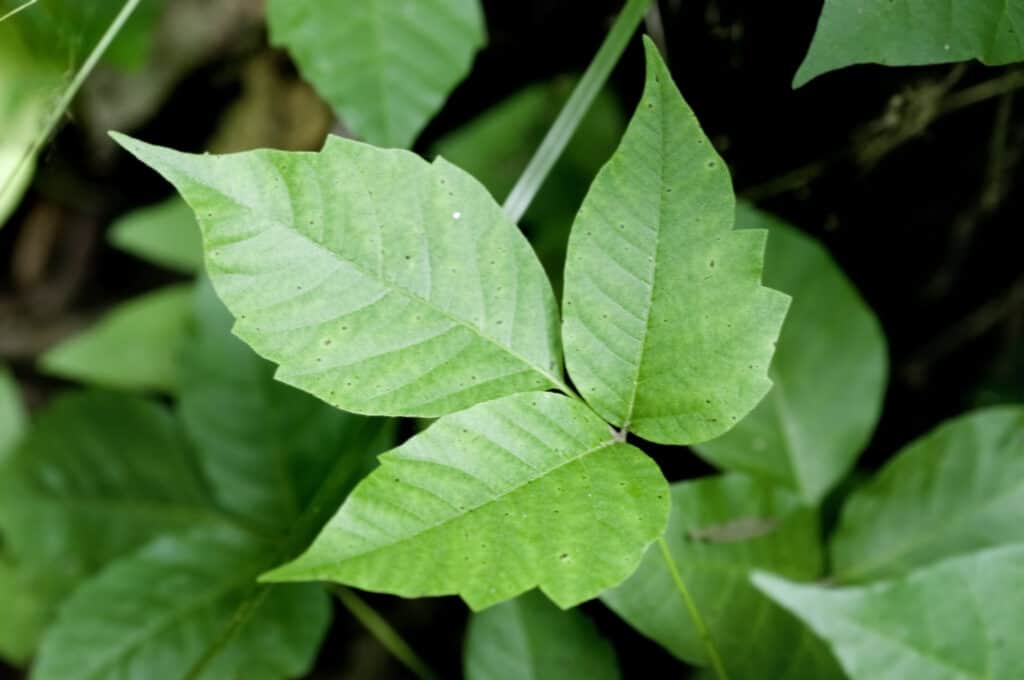
Poison ivy plants come in multiple varieties that exhibit different characteristics.
©Tim Mainiero/Shutterstock.com
| Poison Ivy | |
|---|---|
| Scientific name | Toxicodendron radicans |
| Type of plant | Deciduous |
| Distribution | Eastern half of North America, isolated populations in Arizona |
Many people know poison ivy as an allergenic plant. It can be commonly found throughout the eastern half of North America, although there are also isolated populations in Arizona. The species is infamous for causing contact dermatitis induced by urushiol. This is an oil found inside the sap of the poison ivy plant. If you come across a specimen, you’re one touch away from itches and a painful rash.
It can be difficult to identify poison ivy plants, as they come in multiple varieties with different characteristics. For example, you can find poison ivy specimens as climbing vines using trees as support, as shrubs that can be as tall as 4 feet (1.2 m), or as trailing vines that can be up to 4-10 inches (10-25 cm) tall.
But how can you manage to steer clear of a solid rash? People have come up with three sayings to help you. Namely, if you see “leaves of three, let it be,” since poison ivy features clusters of three leaves each; then, if you see a “hairy vine, no friend of mine,” as poison ivy vines have red hairs on them; last but not least, if you see “berries white, run in fright” (or “danger in sight”), as ivy and similar species exhibit white fruit.
8. Thimbleweed
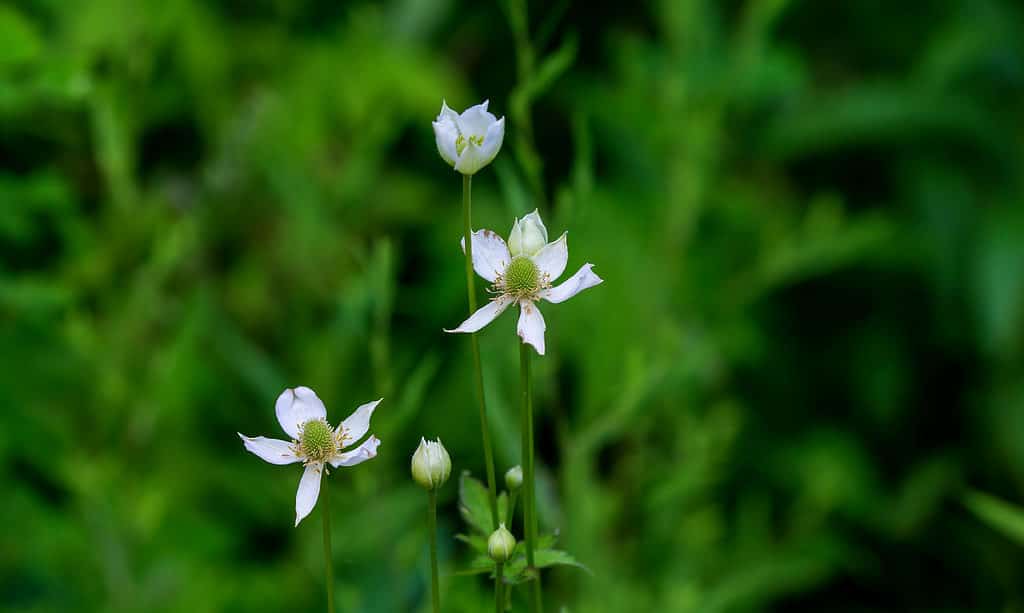
The thimbleweed can be seen growing up to 12-31 inches tall.
©iStock.com/Karel Bock
| Thimbleweed | |
|---|---|
| Scientific name | Anemone virginiana |
| Type of plant | Perennial |
| Distribution | In 38 out of 50 states, including New Hampshire |
The thimbleweed can be seen growing up to 12-31 inches (30-80 cm) tall and is easily spotted thanks to its bright white flowers adorned by a multitude of yellow-green disc florets. The plant is native to 38 out of the 50 states of the U.S. This means that you have the chance of seeing it throughout the entire country, especially in open or dry woods, as this species prefers them.
Anemone virginiana is named thimbleweed thanks to its thimble-shaped pistil. Because this nickname knows multiple species, Anemone virginiana is often referred to as the tall anemone.
Up Next:
- Discover These 10 Magnificent Waterfalls in New Hampshire
- The 10 Biggest Lakes in New Hampshire
- Discover the 10 Best State & National parks in New Hampshire
The photo featured at the top of this post is © iStock.com/Justin Smith
Thank you for reading! Have some feedback for us? Contact the AZ Animals editorial team.







